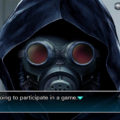Zero Time Dilemma — A Noticeable Shift

It couldn’t have been clearer from previews that Zero Time Dilemma was going to be a very different experience compared to predecessors 999: Nine Hours, Nine Persons, Nine Doors and Virtue’s Last Reward. In the three years since it’s released, it’s been tough not to read impressions from fans who played it, enough to know that many of them felt this installment wasn’t on par with the previous titles.
This was inevitable given how the team approached this game. Director Kotaro Uchikoshi and his team were also going to have a tough time topping the well-executed twists both the predecessors contained. ZTD is indeed not on par with them in terms of quality, but it’s nonetheless worth playing for anyone desiring closure.
[This game is a sequel to two story-driven games, meaning there will be big spoilers for 999 and Virtue’s Last Reward here. I couldn’t avoid them. I won’t be too mad if you stop here.]

ZTD quite literally starts off right where VLR ended, with the characters arriving in a testing facility in the Nevada desert. Like previous titles, there are nine central characters, who are subsequently split into three teams: Team C (Carlos, Junpei, and Akane), Team Q (Q, Eric, and Mira), and Team D (Diana, Sigma, and Phi). Instead of the Nonary Game or the AB Game, they’re forced to play the Decision Game by Zero II. The stakes are immediately higher here, when the game begins by having all three teams vote for another team; the team that receives two votes will be immediately executed, really escalating things quickly. Also like the previous titles, the game splits into multiple paths for different story scenarios depending on the decisions made early on. Fortunately, the flowchart is similar to VLR in how simple it is to shift to different paths, unlike the updated version of 999 — a game clearly not designed for one in mind.
Remarkably, the story pushes the player right into the heat of the drama with little prior exposition. There’s no explanation of what occurred in the previous games unless you read the in-game documents, a far-from-ideal solution to getting caught up. The game clearly exists for fans who played the previous games and wanted a final chapter after VLR’s cliffhanger. Four of the participants return from previous games: Junpei and Akane are back from 999 (and VLR), while Sigma and Phi are from VLR. Diana isn’t a returning character per se, but was the base for a robotic character in VLR. Playing the first two games is essential, even if you didn’t heed my warning above and read some serious spoilers.

Like the previous games, the story is rife with twists regarding how the Decision Game works in ZTD, several (but not all) of which I couldn’t predict. But the biggest among them aren’t quite as ingenious as the biggest ones in 999 and VLR. There’s nothing on par with the reveals that you’re playing Akane the entire time instead of Junpei (999) or that your main character is actually an older man (VLR) this time. Big twists like that can’t be easily concocted, and Uchikoshi and the development team struggled to match the brilliance of the previous titles. But they gave it a good shot.
In fact, the format of the Decision Game doesn’t work as well as the Nonary or AB Games. The biggest issues involves how the teams spend all their time separated from each other early on. The best conversations and reveals emerged when most, if not all, the characters were assembled together in the previous games. Characters were split up when they ventured into different rooms in the previous games, but they don’t talk among each other anywhere near as often this time around. Most of the banter is happening among the same three split teams, and the conversations they just aren’t as interesting. This does improve later, as you might imagine.

The characterization in places doesn’t help. The writers apparently forgot what Junpei was like in 999, who now frequently displays dickish qualities while showing shades of his older self. He also displays qualities of his literal older self from VLR, which shouldn’t be present at this point. Akane can be brazenly incompetent at points, despite being the literal mastermind of 999 and another grandiose plan in VLR. There’s also a twist about one particular character that couldn’t have been easier for players to spot, and is too tolerated afterward. The writing is strongest around Team D — Diana, Sigma, and Phi. It’s easy to see how Luna from VLR was based on Diana, since the former inherited the latter’s characteristics. The writers did remember Sigma and Phi’s characterization from VLR.
ZTD’s presentation is drastically different compared to the previous games, and not entirely for the better. 999 and VLR were primarily aimed towards the Japanese audience, and inherited a traditional Japanese visual novel presentation. But after those games performed much better in western territories, the team decided to mimic popular American adventure games — especially titles from the late (and somewhat reborn) Telltale Games. Imagine if they made one of their games with around half the budget at most. The character animations here are stiff, and the facial animations can sometimes be so ill-fittingly hilarious that they nearly ruin some key dramatic moments. The character models are more detailed, but VLR’s were better animated — Clover’s weirdly permanent smile notwithstanding.

The game retains the puzzle rooms from the previous game for each of the teams to tackle. Many are just as, if not more, difficult than those from the prior games. I found myself stumped on a few, often in cases were the solutions were deceptively simple. Other solutions were difficult for anyone repelled by the mere sight of numbers. The puzzles aren’t fewer in number, but they’re mostly relegated to the first half of the game. They also only involve the same three teams, with no option to switch them up for alternate conversations like the previous games, which makes them a little less enjoyable.
The voice acting is mostly good, though some actors struggled with more dramatic moments. The biggest offender here was Rena Strober as Akane, who seemed not to know the right emotional pitches to take during some moments. She’s a good actress, evinced by how she’s much improved in the updated version of 999 in The Nonary Games collection (released after ZTD), so the voice direction is the likely culprit here. The soundtrack is good, though most of the music is reused from the previous games, in another sign of just how low a budget Spike Chunsoft assigned for this project. Those old tracks are used well, however.
You’ve undoubtedly received my impression that Zero Time Dilemma is not quite on par with its superlative predecessors. But I still had a good time with it, and the game provides mostly-good closure to the three-game story. It’s evident the team had less resources to assemble this game thanks to how sales of the previous games came up short in Japan, but at least they’re still getting the chance to work on other projects.





